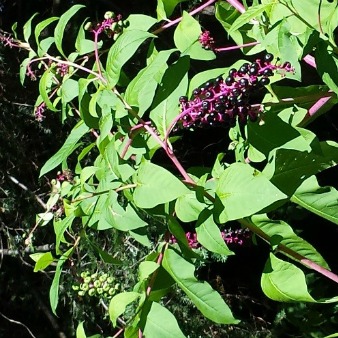
Written and performed by Tony Joe White, and other artists like Elvis, it describes the lifestyle of a poor country girl from the South. Sally’s Polk Salad refers to the pokeberry plant, all parts of which are poisonous. Pokeberry has been used as a food staple in the southern states for years. Experts at Medline Plus, a website of the National Institute of Health, point out that even then there is no guarantee that pokeberry is safe to eat and they emphasis that the roots should never be eaten, as they contain the most toxins, Phytolaccatoxin and Phytolaccigenin.
It is easy to glimpse the tall colorful forms of pokeberry this time of year along roadsides or in the scrubby areas between field and forest in the Blackstone Heritage Corridor. They are distinctive bushes with their long bunches of grape-like fruits. Pokeberry is a dramatic perennial and native of most of the Americas; also called inkberry, pokeroot and pokeberry. Its botanical name Phytolacca Americana is derived from the Latin word, lacca, meaning “red dye,” an obvious fact is you have every gotten squished berries on hands or clothing.
The plant has redeeming features. It is an attractive addition to a landscape of native plants. The berries are usable as both an ink and dye. They do provide a food supply to the wildlife in the Blackstone Heritage Corridor, ourselves excluded!